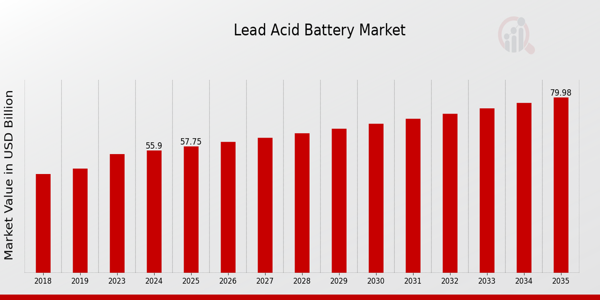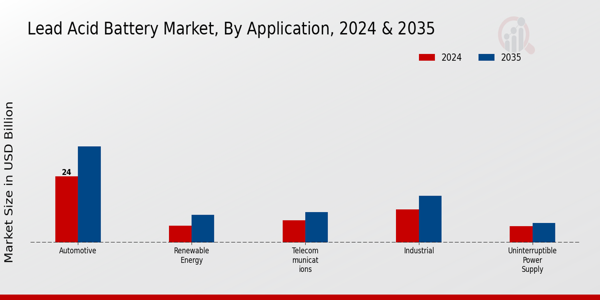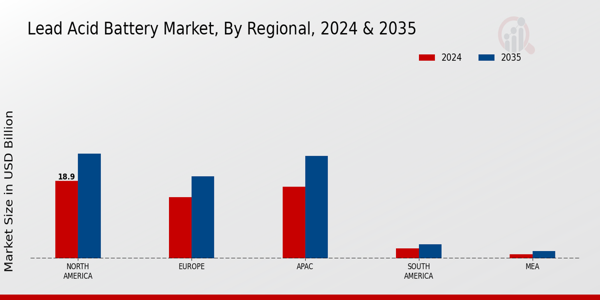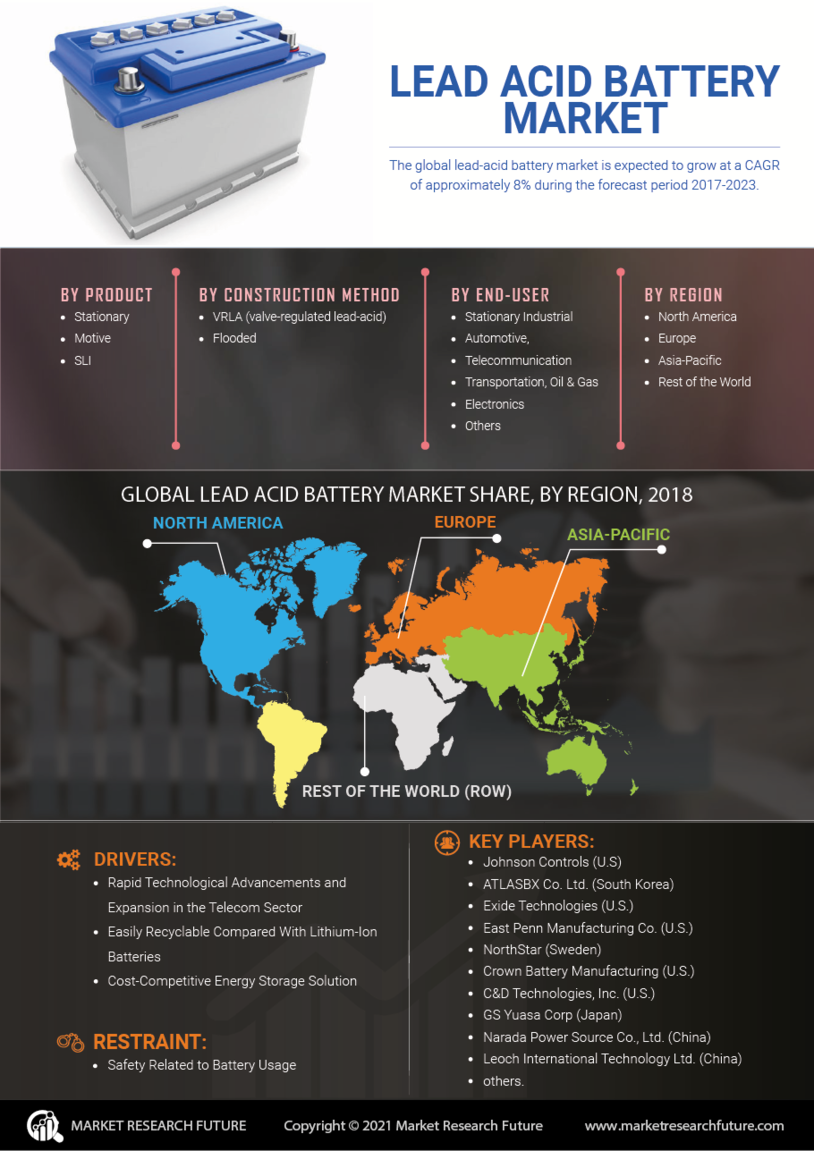Global Lead Acid Battery Market Overview:
As per MRFR analysis, the Lead Acid Battery Market Size was estimated at 54.11 (USD Billion) in 2023. The Lead Acid Battery Market Industry is expected to grow from 55.9 (USD Billion) in 2024 to 80 (USD Billion) by 2035. The Lead Acid Battery Market CAGR (growth rate) is expected to be around 3.31% during the forecast period (2025 - 2035).
Key Lead Acid Battery Market Trends Highlighted
The Lead Acid Battery Market is experiencing notable trends driven by various factors. One significant market driver is the growing demand for renewable energy sources. Lead acid batteries are increasingly being used for energy storage in solar and wind systems, complementing global efforts to shift towards sustainable energy solutions. This trend reflects a broader commitment to environmental preservation and the reduction of carbon footprints, as many countries introduce policies and incentives to promote renewable energy adoption.
Additionally, the automotive industry is transitioning more towards electric vehicles (EVs), which primarily utilize lead acid batteries for their secondary power needs. The need for dependable and affordable energy storage systems is increasing. There are other important opportunities in the market, such as increasing technology for lead acid batteries. Research and development of new materials or methods for improving the sustainability of lead acid batteries could greatly impact environmental initiatives. Recently, there has been a clear movement towards a circular economy in lead acid batteries. There is greater attention to battery recycling services which indicate reduced waste and enhanced resource use efficiency.
This supports the initiatives laid out by various global environmental regulations aimed at reducing hazardous waste and promoting sustainability. Moreover, as developing countries enhance their infrastructure and electrification efforts, the market is poised to capture opportunities in these emerging economies, fueling growth in the lead acid battery market.

Source: Primary Research, Secondary Research, MRFR Database and Analyst Review
Lead Acid Battery Market Drivers
Growing Demand for Renewable Energy Storage Solutions
The increase in renewable energy generation, particularly solar and wind, is driving the need for efficient energy storage solutions. According to the International Renewable Energy Agency, global renewable energy capacity reached 2,799 gigawatts in 2020, representing a year-on-year increase of 10.3%. Regional efforts to enhance energy independence and reduce carbon emissions have led to the adoption of Lead Acid Batteries for storage.
The Lead Acid Battery Market Industry is poised to benefit from these trends as governments worldwide, including those in Europe and the United States, incentivize the use of renewable energy sources. For instance, the U.S. Department of Energy announced initiatives aimed at supporting energy storage research and development, further promoting lead-acid battery technologies as part of the overall renewable energy infrastructure.
Increasing Usage of Electric Vehicles
Electric Vehicles (EVs) are becoming more popular globally, and Lead Acid Batteries are an essential component in many lower-cost EV applications. With the global electric vehicle market projected to reach 145 million units by 2030, according to the International Energy Agency, the Lead Acid Battery Market Industry is experiencing increased demand. Governments, such as the European Union and China, have established strict emissions targets promoting the growth of the EV market, which consequently boosts demand for Lead Acid Batteries used in starter motors and energy storage for electric vehicles. This significant increase signifies a trend that will likely sustain and grow the market further.
Regulatory Support for Battery Recycling
With the expansion of recycling regulations globally, there is a growing emphasis on sustainability within the battery industry. The United Nations Environment Programme highlights that properly recycling Lead Acid Batteries not only recovers lead but also maintains economic viability for manufacturers. Approximately 99% of Lead Acid Batteries are recycled globally, making it one of the most recycled products in the world.
As countries tighten regulations on waste and promote recycling initiatives, it furthers the Lead Acid Battery Market Industry's growth. For instance, regulations in regions such as the European Union advocate for the responsible disposal and recycling of batteries, incentivizing businesses to integrate more sustainable practices which subsequently boosts the market demand.
Technological Advancements in Battery Manufacturing
Advancements in battery technology have led to improved performance and longevity of Lead Acid Batteries, increasing their appeal across various sectors. Innovations, such as enhanced separator technology and advanced lead alloys, significantly improve battery efficiency and lifespan. As reported by the Battery Innovation Hub, widespread adoption of new manufacturing processes enhances product quality.
The Lead Acid Battery Market Industry is positioned to benefit from these advancements as industries, including telecommunications and automotive, increasingly seek reliable and efficient power solutions. Given the ongoing Research and Development activities funded by various corporations and health organizations, we can expect continuous improvements that will drive market growth.
Lead Acid Battery Market Segment Insights:
Lead Acid Battery Market Application Insights
The Lead Acid Battery Market exhibits substantial diversification across distinct applications, contributing significantly to the overall market landscape. The valuation for 2024 stood at 55.9 USD Billion, displaying the prominent role of lead acid batteries in various sectors. The Automotive application held a majority share, valued at 24.0 USD Billion in 2024, and is essential for vehicle starting, lighting, and ignition systems. This segment's dominance can be attributed to the ongoing expansion of the automotive industry, which is witnessing heightened production rates and increasing reliance on electric and hybrid vehicles.
Furthermore, the Industrial segment, valued at 12.0 USD Billion in 2024, plays a significant role by providing power solutions for material handling equipment and backup power systems, crucial in maintaining operational efficiency. The Telecommunications sector, valued at 8.0 USD Billion, underlines the importance of uninterrupted power supply for communication networks, which are critical for both personal and business connectivity. The Renewable Energy segment was valued at 6.0 USD Billion in 2024, which links the growing demand for energy storage technologies, especially with the rise of solar and wind power installations requiring efficient and reliable batteries.
Lastly, the Uninterruptible Power Supply application, valued at 5.9 USD Billion in 2024, is vital for maintaining power during outages and supporting essential services across sectors like healthcare and data centers. Collectively, the insights from these segments reveal a dynamic landscape for the Lead Acid Battery Market, characterized by a steady growth trajectory supported by diverse applications driven by the increasing need for reliable power sources in various industries.
As the market evolves, growth drivers such as technological advancements, regulatory support for renewable energy, and the expansion of telecommunication networks will continue to shape the competitive landscape, presenting both challenges and opportunities for market players in this space. Hence, the Lead Acid Battery Market segmentation reflects not only the financial potential but also the critical role that lead acid batteries play across different real-world applications.

Source: Primary Research, Secondary Research, MRFR Database and Analyst Review
Lead Acid Battery Market Type Insights
The Lead Acid Battery Market is segmented into various types, each playing a crucial role within the industry. In 2024, the overall market was valued at 55.9 USD Billion, reflecting the importance of lead acid batteries in various applications such as automotive, telecommunications, and renewable energy storage. Flooded Lead Acid Batteries, often favored for their cost-effectiveness and reliability, hold a substantial share due to their widespread applications. Sealed Lead Acid Batteries are also significant, as they require less maintenance and are increasingly used in consumer electronics and emergency lighting systems.
The market for Absorbent Glass Mat Batteries is on the rise, particularly in motorcycles and marine applications, thanks to their ability to provide superior performance and safety. Vent Valve Regulated Batteries are gaining traction as they offer a sealed design that minimizes maintenance and prevents electrolyte leakage, making them ideal for various usage scenarios. With projected market growth driven by demand for electric vehicles and renewable energy storage systems, the Lead Acid Battery Market continues to evolve, presenting robust opportunities in numerous segments.
Lead Acid Battery Market End Use Insights
The Lead Acid Battery Market reached a valuation of 55.9 USD Billion by 2024, underscoring its significant role across various end use applications. Within this market, transportation is a key segment that is vital due to the extensive utilization of lead acid batteries in automotive and commercial vehicles. Backup power also plays a crucial role, offering reliable energy solutions during outages and emergencies, which complements the needs of businesses and households alike. Energy storage has gained traction globally as renewable energy sources become more prominent, allowing for efficient energy management.
Furthermore, electric vehicles are rapidly advancing, showcasing the transition towards more sustainable modes of transport. The market growth is supported by increasing demand for electrification and the rising need for efficient power solutions. However, challenges such as environmental concerns and recycling issues linger. Despite these hurdles, the demand for lead acid batteries across these various applications presents significant growth opportunities, ultimately shaping the future landscape of the Lead Acid Battery Market.
Lead Acid Battery Market Maintenance Type Insights
The Lead Acid Battery Market is witnessing significant growth, particularly in the Maintenance Type segment, which includes Maintenance-Free and Regular Maintenance categories. In 2024, the overall market was valued at 55.9 USD Billion, reflecting strong demand for lead acid batteries across various applications. Maintenance-Free batteries are gaining traction due to their convenience, lower operational costs, and increasing use in sectors such as automotive and renewable energy. They significantly reduce the time and resources companies must spend on upkeep, making them a preferred choice in today's fast-paced market.
Conversely, Regular Maintenance batteries continue to hold a substantial share, particularly in industrial applications, where the performance and longevity of batteries are critical. Companies often find that investing in Regular Maintenance ensures optimal performance, thus extending battery life and reducing downtime. This balance between the two categories illustrates how the Lead Acid Battery Market is evolving, providing opportunities for manufacturers to innovate and meet changing consumer needs while aligning with global trends towards energy efficiency and sustainable practices. The market growth is expected to reflect advancements and developments in battery technologies, thereby driving increased adoption across multiple sectors.
Lead Acid Battery Market Regional Insights
The Lead Acid Battery Market has seen robust growth across various regions, with North America led the charge and holding a significant market share, valued at 18.9 USD Billion in 2024, projected to reach 25.6 USD Billion by 2035. Europe closely followed, with a valuation of 15.0 USD Billion in 2024 and anticipated growth to 20.1 USD Billion in 2035, driven by stringent regulations promoting renewable energy solutions. The Asia-Pacific (APAC) region, with a market value of 17.5 USD Billion in 2024, is expected to grow to 25.0 USD Billion by 2035, underpinned by increasing industrialization and demand for energy storage systems.
South America and the Middle East and Africa (MEA), while comparatively smaller, also contributed to the Lead Acid Battery Market revenue, with valuations of 2.5 USD Billion and 1.0 USD Billion in 2024, respectively, growing to 3.5 USD Billion and 1.8 USD Billion by 2035. The disparities in market sizes reflect the varying industrial growth rates and energy demands across these regions, positioning North America and APAC as crucial players due to their majority holding and significant influence in global market trends. Overall, the Lead Acid Battery Market statistics indicate a steady evolution influenced by technological advancements and changing energy consumption patterns.

Source: Primary Research, Secondary Research, MRFR Database and Analyst Review
Lead Acid Battery Market Key Players and Competitive Insights:
The Lead Acid Battery Market is characterized by intense competition among various players striving to gain a larger share of the market. These batteries are crucial for a myriad of applications, including automotive, telecommunications, and renewable energy storage. The market is influenced by several factors, such as advances in technology, increasing demand for energy storage systems, and a growing focus on renewable energy sources. Competitors are continuously innovating and transforming their product offerings to enhance performance, longevity, and sustainability. Additionally, regional differences in regulations, production capabilities, and market demand contribute to the competitive landscape. In this dynamic environment, understanding the strengths and weaknesses of key players is essential for forming strategies to thrive in the market.
Enersys stands out in the Lead Acid Battery Market due to its extensive product range and strong market presence. The company specializes in advanced lead-acid batteries for various applications, including data centers, utilities, and industrial sectors. With a robust global footprint, Enersys is able to cater to numerous clients regardless of location by leveraging its manufacturing and distribution capabilities. The company's dedication to research and development enables it to continually improve the lifecycle and efficiency of its battery products. Enersys focuses on providing value-added services and customized solutions, which further enhances customer loyalty and retention. Their well-established reputation and brand recognition solidify their competitive position within the landscape.
On the other hand, Amara Raja Batteries plays a pivotal role in the Lead Acid Battery Market, primarily known for its innovative product offerings and strong commitment to sustainability. The company provides a large portfolio of lead-acid batteries catering to various segments, including automotive and industrial applications. Amara Raja Batteries is recognized for its advanced manufacturing facilities and focus on quality control, which contributes to the high performance and reliability of its products. The company has strategically expanded its market presence through mergers and acquisitions, which not only increases its capabilities but also enhances its competitive edge. By investing in cutting-edge technology and sustainable practices, Amara Raja Batteries aims to offer products that meet the evolving needs of customers, positioning itself as a leader in the global market for lead-acid batteries.
Key Companies in the Lead Acid Battery Market Include:
- Enersys
- Amara Raja Batteries
- East Penn Manufacturing
- Exide Technologies
- Duracell
- Luminous Power Technologies
- Concorde Battery Corporation
- Yuasa Battery
- Johnson Controls
- Atlas Copco
- Furukawa Battery
- Sonnenschein
- GS Yuasa
- Trojan Battery Company
Lead Acid Battery Market Industry Developments
In the Lead Acid Battery Market, recent developments include significant growth in battery demand due to the rising need for energy storage solutions and the expanding automotive sector. Companies like Enersys and Exide Technologies have been focusing on innovative designs and applications, particularly in renewable energy integration. Production capacities are being ramped up, with Amara Raja Batteries and East Penn Manufacturing reporting increased investments to meet this growing demand. Notably, in September 2023, Johnson Controls announced strategic advancements in technology aimed at improving battery lifespan and efficiency, reflecting the industry's shift towards sustainability.
Furthermore, in July 2022, Yuasa Battery and Furukawa Battery entered into a collaboration to enhance manufacturing capabilities. These partnerships signify recognition of the industry’s growing dynamics. The market is witnessing changes in valuations, with firms like Duracell and Luminous Power Technologies experiencing improved financial performances. Additionally, as of August 2023, Trojan Battery Company launched an upgraded product line targeting the renewable energy market, emphasizing the transition to cleaner energy storage solutions. The focus remains on adapting to technological advancements and market demands as the global lead acid battery sector evolves.
Lead Acid Battery Market Segmentation Insights
Lead Acid Battery Market Application Outlook
- Automotive
- Industrial
- Telecommunications
- Renewable Energy
- Uninterruptible Power Supply
Lead Acid Battery Market Type Outlook
- Flooded Lead Acid Batteries
- Sealed Lead Acid Batteries
- Absorbent Glass Mat Batteries
- Vent Valve Regulated Batteries
Lead Acid Battery Market End Use Outlook
- Transportation
- Backup Power
- Energy Storage
- Electric Vehicles
Lead Acid Battery Market Maintenance Type Outlook
- Maintenance-Free
- Regular Maintenance
Lead Acid Battery Market Regional Outlook
- North America
- Europe
- South America
- Asia Pacific
- Middle East and Africa
| Report Attribute/Metric Source: |
Details |
| MARKET SIZE 2023 |
54.11 (USD Billion) |
| MARKET SIZE 2024 |
55.9 (USD Billion) |
| MARKET SIZE 2035 |
80.0 (USD Billion) |
| COMPOUND ANNUAL GROWTH RATE (CAGR) |
3.31% (2025 - 2035) |
| REPORT COVERAGE |
Revenue Forecast, Competitive Landscape, Growth Factors, and Trends |
| BASE YEAR |
2024 |
| MARKET FORECAST PERIOD |
2025 - 2035 |
| HISTORICAL DATA |
2019 - 2024 |
| MARKET FORECAST UNITS |
USD Billion |
| KEY COMPANIES PROFILED |
Enersys, Amara Raja Batteries, East Penn Manufacturing, Exide Technologies, Duracell, Luminous Power Technologies, Concorde Battery Corporation, Yuasa Battery, Johnson Controls, Atlas Copco, Furukawa Battery, Sonnenschein, GS Yuasa, Trojan Battery Company |
| SEGMENTS COVERED |
Application, Type, End Use, Maintenance Type, Regional |
| KEY MARKET OPPORTUNITIES |
Growing demand for renewable energy, Expansion of electric vehicle market, Increasing applications in UPS systems, Technological advancements in battery recycling, Rising investments in energy storage solutions |
| KEY MARKET DYNAMICS |
Increasing demand for renewable energy, Growing electric vehicle adoption, Technological advancements in battery design, Rising use in backup power systems, Stringent environmental regulations |
| COUNTRIES COVERED |
North America, Europe, APAC, South America, MEA |
Lead Acid Battery Market Highlights:
Frequently Asked Questions (FAQ) :
The Lead Acid Battery Market is expected to be valued at 55.9 USD Billion in 2024.
By 2035, the Lead Acid Battery Market is projected to reach 80.0 USD Billion.
The expected CAGR for the Lead Acid Battery Market from 2025 to 2035 is 3.31%.
North America is expected to dominate the Lead Acid Battery Market with a valuation of 18.9 USD Billion in 2024.
The market size for the Automotive application is projected to be 35.0 USD Billion by 2035.
The market size for the Industrial application in 2024 is valued at 12.0 USD Billion.
Key players in the market include Enersys, Amara Raja Batteries, East Penn Manufacturing, and Exide Technologies.
The Telecommunications application is projected to reach a market size of 11.0 USD Billion by 2035.
The projected market size for the Renewable Energy application in 2024 is 6.0 USD Billion.
The expected market size for the MEA region by 2035 is 1.8 USD Billion.


















